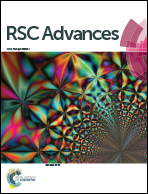Monoammonium salts of multiprotic acids as dopants for proton-conductive hydrogel membranes: the effects of anions
Abstract
Monoammonium salts of diprotic acid (NH4HSO4) and triprotic acid (NH4H2PO4), whose cations and anions are both potential proton carriers, were employed as dopants for proton-conductive hydrogel membranes to explore the effects of anions on thermal, mechanical, and electrochemical performance. Robust hydrogel membranes were obtained by radical copolymerization of acrylamide and ethylene glycol dimethacrylate dissolved in aqueous solutions of NH4HSO4 and NH4H2PO4. By virtue of the protonated ammonium cation, the ionic conductivities of the hydrogels doped with NH4HSO4 and NH4H2PO4 were superior to those doped with the corresponding inorganic acids (H2SO4 and H3PO4). The hydrogel doped with NH4HSO4 exhibited a higher ionic conductivity but lower mechanical strength and thermostability than that with NH4H2PO4. Ionic conduction in the doped hydrogels was dominated by the vehicle mechanism and NH4HSO4 resulted in lower activation energy for the conduction than NH4H2PO4. In addition, the fuel cell performances of the hydrogel membranes at room temperature were evaluated.



 Please wait while we load your content...
Please wait while we load your content...